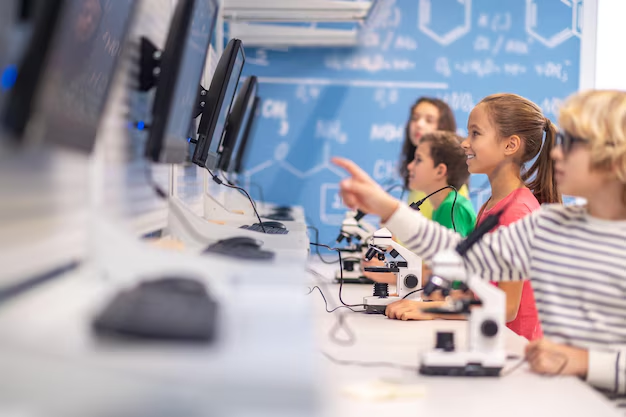In the past few decades, education has undergone a radical transformation, thanks in large part to the rapid advancement of technology. From smart classrooms and online learning platforms to artificial intelligence (AI) and virtual reality (VR), technology is no longer just a tool used in education; it has become an essential part of the learning process. As we continue to navigate the digital era, technology is revolutionizing education by making learning more accessible, engaging, and personalized.
This article explores how technology is reshaping the classroom experience, transforming how students learn, how teachers teach, and how education systems operate.
The Rise of Digital Learning Tools
1. Smart Classrooms and Interactive Learning
One of the most visible changes in education today is the shift toward smart classrooms. These classrooms are equipped with interactive whiteboards, projectors, and digital devices, allowing teachers and students to collaborate and engage in more dynamic lessons. Smart boards, for example, enable teachers to present lessons with multimedia content such as videos, images, and interactive activities, making learning more engaging and hands-on.
Furthermore, tablets, laptops, and other digital devices have made it easier for students to access resources, collaborate with peers, and conduct research without leaving the classroom. These tools empower students to take more ownership of their learning, enabling them to access information in real-time and learn at their own pace.
2. Online Learning Platforms: Bridging the Gap
Online learning platforms such as Coursera, Udemy, and Khan Academy are revolutionizing education by providing students with access to a wide array of courses and resources outside traditional classrooms. These platforms enable self-paced learning, where students can choose from a vast range of subjects, from technical skills to humanities.
In addition to providing students with flexibility, online platforms also offer a more inclusive approach to education. Students from all over the world can access high-quality education, regardless of their location or economic background. This democratization of knowledge has the potential to significantly reduce the global education gap and offer equal opportunities for learning.
3. Artificial Intelligence in the Classroom
AI is increasingly playing a key role in personalizing education. AI-driven platforms can adapt to a student’s learning style and pace, delivering customized lessons based on their strengths and weaknesses. For example, platforms like DreamBox and Squirrel AI use algorithms to assess students’ progress and tailor lessons to meet their individual needs.
Furthermore, AI tools can assist teachers in grading assignments, analyzing student data, and identifying areas where students may need additional help. This not only saves teachers time but also helps them provide more targeted support to students.
4. Virtual Reality and Augmented Reality: Making Learning Immersive
Virtual reality (VR) and augmented reality (AR) are technologies that have the potential to take education to the next level by making learning more immersive and interactive. VR, for example, can transport students to historical events or scientific environments, offering them a first-person experience of concepts they would otherwise only encounter in textbooks.
For instance, students studying history can virtually visit ancient civilizations, while those in science classes can explore the human body or outer space. By offering students the ability to engage with complex concepts in a more interactive and sensory way, VR and AR make learning more enjoyable and impactful.
5. Gamification: Learning Through Play
The use of gamification in education is another example of how technology is transforming classrooms. By incorporating game-like elements such as rewards, challenges, and leaderboards, teachers can motivate students to engage more deeply with the content. Gamification not only enhances learning outcomes but also makes education more fun and enjoyable.
Educational games and apps such as Kahoot! and Duolingo use gamification to make subjects like language learning and math more interactive. This approach is especially effective for younger students, who benefit from the playful and competitive aspects of games that help reinforce knowledge in an enjoyable way.
6. Cloud Computing and Collaborative Tools
Cloud computing has transformed the way students and teachers collaborate. Tools like Google Classroom and Microsoft Teams allow for real-time communication, file sharing, and group collaboration on assignments. Cloud-based platforms make it easier for students to work together on projects, regardless of their location.
These tools also provide teachers with the ability to track student progress and manage assignments efficiently. The flexibility of cloud computing has made remote learning and hybrid classrooms more feasible, ensuring that education continues even when in-person learning is not possible.
7 Frequently Asked Questions about Technology in Education
1. How has technology made learning more accessible?
Technology has made learning more accessible by providing online courses, digital resources, and tools that allow students to learn at their own pace, regardless of their location or economic status. Online learning platforms have democratized education, giving people from all walks of life access to high-quality content.
2. Is technology replacing teachers?
No, technology is not replacing teachers; it is enhancing their ability to teach. AI and digital tools support teachers by automating administrative tasks, providing personalized learning experiences, and helping with assessment. Teachers still play a crucial role in guiding students and fostering creativity and critical thinking.
3. How does AI personalize education?
AI personalizes education by adapting lessons to a student’s learning pace and style. It tracks progress, identifies strengths and weaknesses, and adjusts the content to suit individual needs. This ensures that each student receives tailored support and learns at their own speed.
4. Can virtual reality really enhance learning?
Yes, virtual reality (VR) can significantly enhance learning by providing immersive experiences that engage students in new ways. VR enables students to interact with complex subjects, such as history, science, and geography, in a hands-on, visual manner that traditional textbooks cannot replicate.
5. What is gamification, and how does it help in education?
Gamification is the incorporation of game-like elements into learning activities. It includes rewards, challenges, and competition to make learning more fun and engaging. This approach motivates students to participate actively and enhances retention through interactive and enjoyable experiences.
6. Is technology in education only for higher education?
No, technology is being used at all levels of education, from elementary schools to universities. In fact, tools like interactive whiteboards, educational apps, and online learning platforms are making learning more engaging and accessible for students of all ages.
7. What is the future of education with technology?
The future of education with technology will see even more personalized, interactive, and immersive learning experiences. Virtual reality, AI, and other technologies will continue to evolve, offering students new ways to learn and collaborate while making education more accessible globally.
Conclusion
Technology has already had a profound impact on education, and its role will only continue to expand in the years to come. From smart classrooms and online learning platforms to AI-driven personalized education and virtual reality, technology is transforming how students engage with content and how teachers deliver lessons.
As we look to the future, the key to revolutionizing education will be to harness the potential of these technologies while ensuring that they are used to enhance learning experiences, rather than replace human connection and guidance.
Key Takeaways
- Technology is transforming education by making learning more interactive, personalized, and accessible through tools like smart classrooms, AI, VR, and online platforms.
- AI and machine learning help personalize education by adapting to each student’s pace and providing tailored support.
- Virtual and augmented reality provide immersive learning experiences, allowing students to interact with complex concepts in a more engaging and hands-on way.
- Gamification makes learning fun and motivates students to actively participate and retain information.
- The future of education lies in continuing to integrate technology to enhance learning while maintaining the essential role of teachers in fostering creativity and critical thinking.

